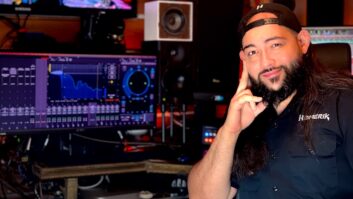BOSTON, MA—Like many aspirational producer/engineers, Jimmy Fox—a Boston-area musician— has been recording a wide range of musical acts for years now, all out of his basement. Fox has long realized the importance of proper pro-grade recording gear, following his favorite productions and what gear they have chosen.
A 16-channel Harrison 950mx analog console resides in Jimmy Fox’s personal production space for his label, Sadawala Music Everything. “I’m a musician, a guitar player to start,” explains Fox. “I’ve been doing albums for quite a long time. They’ve ranged from productions in my living room to ones with ‘real’ engineers, too. Over time, musicians pick up what to do to make a recording. With the way the music industry has gone, it makes sense in the long run to have your own gear, and quality gear at that.”

Running FunkBunker Studio out of his basement and his own label, Sadawala Music Everything, Fox recently found it necessary to upgrade from “two really good channels both in and out” to “an overall higher level of fidelity” by installing a Harrison 950mx analog console as his production centerpiece. “Because my musical interests are varied—I do everything from hip-hop to bluegrass— but I’m a guitar player first, [predominantly analog signal chains] have always sounded better,” Fox explains of his early dependence on a Burl Mothership, a 500-Series chassis with a reportedly “tape-like” AD/DA converter flavor, another pro-grade I/O investment. “I’ve also invested in good summing out of the box, and a couple of tube channels on inputs. And my future is Dante-based, so I’m looking forward to networking options, too. Now with the Harrison console, I’m meeting this higher level of fidelity in the middle with no compromises. The more space you allow for each sound, the better off you’ll be.”
Fox’s Harrison 950mx is comprised of a 16-channel frame featuring eight mono channels and four stereo channels. With its four open slots, Fox’s 950mx can ultimately provide 24 inputs and outputs, in any split mono/stereo channel configuration. “I can get those channels when I’ve grown to that point and I’m ready,” explains Fox on the value of investing in an expandable, modular mixing console. “On the mono channels, that Harrison fully-sweepable EQ is there; it’s the Bruce Swedien-preferred Harrison EQ he used for many years. And with the console’s gain staging, there’s a lot of sound-shaping possibilities going on for each specific sound.”
Fox considered all competing brands of analog mixers within his budget, both new and vintage. Ultimately, the Harrison 950mx won out because it offered the most value and “clout” to best serve his clients. “I think that the Harrison is an accepted first choice within all genres, and that’s worldwide,” offers Fox. “That’s one aspect of my choosing it. It’s also very flexible, and being a centerpiece of a room with so many options all built in, it’s best to get the most bang for your buck when you’re making this kind of jump in investment. It’s important to remember that you may not be able to hear something completely until you own it, so it’s important to think about flexibility and real-deal, professional worldwide sound quality from the beginning. This is a board that would be welcomed anywhere around the world; it just so happens that it’s in my basement.”
Fox matched the Harrison 950mx with a monitoring system he felt would be as universally accepted, ultimately choosing English hand-built ProAc studio monitors. “They’re neutral, clear and are known as being well accepted in a wide range of genres,” tells Fox. He also insists that ProAc’s low frequency response is, in general, more accurate than many studio monitors available today. His ProAc system has already provided significant improvements in what he delivers to mastering, too. “On my last bluegrass record—produced before the Harrison and recent upgrades like the ProAc system—my mastering engineer’s first comment was, ‘I added a lot more bass.’ It was directly related to the basement environment where I work; you can’t easily work your way around bass frequency issues [in acoustically compromised environments] without a significant investment in monitors.”
Today, Fox is celebrating the overall “improved fidelity” that his 950mx-centered studio now provides. “With the console, suddenly my judgments are more accurate,” he concludes. “I hear more of the nuance. Each crucial channel—like bass drum, for example—is in a channel of its own, ready for manipulation and more easily controlled. These improvements—such a big console and monitors upgrade—are significant for a guy like me.”
FunkBunker
Sadawala.com







